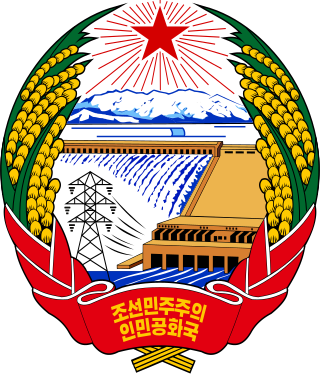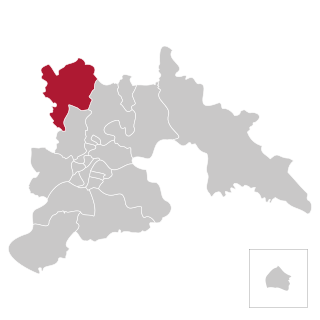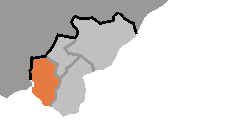
Kaesong is a special city in the southern part of North Korea, and the capital of Korea during the Taebong kingdom and subsequent Goryeo dynasty. The city is near the Kaesong Industrial Region close to the border with South Korea and contains the remains of the Manwoldae palace. Called Songdo while it was the ancient capital of Goryeo, the city prospered as a trade centre that produced Korean ginseng. Kaesong now functions as North Korea's light industry centre.

South Korea is made up of 22 first-tier administrative divisions: 6 metropolitan cities, 1 special city, 1 special self-governing city, and 14 provinces, including three special self-governing provinces and five claimed by the ROK government. These are further subdivided into a variety of smaller entities, including cities, counties, districts, towns, townships, neighborhoods and villages.

The administrative divisions of North Korea are organized into three hierarchical levels. These divisions were created in 2002. Many of the units have equivalents in the system of South Korea. At the highest level are nine provinces and four special municipalities. The second-level divisions are cities, counties, and districts. These are further subdivided into third-level entities: towns, dongs (neighborhoods), ris (villages), and workers' districts.

SinuijuSpecial Administrative Region was a planned special administrative region (SAR) of North Korea based in the city of Sinuiju. Proclaimed in 2002, the SAR was envisioned to be directly governed as in the case of "Directly Governed Cities" but has yet to be put into de facto operation.

Sŏnbong-guyŏk, formerly called Unggi, is a subdivision of the North Korean city of Rason. It is located at the northeastern extreme of North Korea, bordering Russia and China. It lies on Unggi Bay, an extension of the Sea of Japan. A uranium mine is allegedly located there, as is a 200 megawatt oil-fired power plant. The word Sonbong means "Vanguard" in Korean.

Kijŏng-dong, Kijŏngdong, Kijŏng tong or Kaepoong is reportedly a Potemkin village in P'yŏnghwa-ri, Panmun-guyok, Kaesong Special City, North Korea. It is situated in the North's half of the Korean Demilitarized Zone (DMZ). Also known in North Korea as Peace Village, it has been widely referred to as 'Propaganda Village' by those outside North Korea, especially in South Korean and Western media.

Tongdaewŏn-guyŏk or Tongdaewon District is one of the 18 wards, and one of the six that constitute East Pyongyang, North Korea. It sits on the eastern bank of the Taedong River. It is north of Sŏn'gyo-guyŏk, south of Taedonggang-guyŏk and west of Sadong-guyŏk and Ryŏkp'o-guyŏk. It was established in October 1960.

Taedonggang-guyŏk, or Taedong River District, is one of the 18 guyŏk, and one of the six that constitute East Pyongyang, North Korea. Taedonggang-guyŏk is on the eastern bank of the Taedong River, north of Tongdaewŏn-guyŏk and west of Sadong-guyŏk. It was established in January 1958.

Sadong-guyŏk, or Sadong District, is one of the 18 guyŏk, and one of the six, that constitute East Pyongyang, North Korea. It is on the eastern bank of the Taedong River, and the mouth of the Nam River. It is north of Ryŏkp'o-guyŏk, east of Taedonggang-guyŏk and north east of Tongdaewŏn-guyŏk. It was established in September 1959.

Taesŏng-guyŏk, or Taesŏng District is one of the 18 guyok that constitute Pyongyang, North Korea.

Hyŏngjesan-guyŏk, or Hyŏngjesan District is one of the 19 guyŏk that constitute Pyongyang, North Korea.

Ryongsŏng-guyŏk, or Ryongsŏng District (룡성구역) is one of the 18 guyŏk that constitute Pyongyang, North Korea. Ryongsong Residence, the main residence of Kim Jong-un is located in this district.

Samsŏk-kuyŏk, or Samsŏk District is one of the 18 kuyŏk that constitute Pyongyang, North Korea.

Ryŏkp'o-guyŏk, or Ryŏkp'o District, is one of the 18 wards (guyŏk) that constitute Pyongyang, North Korea. This is where part of the Goguryeo tombs of Pyongyang can be found.

Ŭnjŏng-guyŏk, or Ŭnjŏng District is one of the 18 guyŏk that constitute Pyongyang, North Korea, known for its scientific facilities. The district was named as such to honor the "benevolent affection(Korean word is Unjong)" and love of the Kim family towards the country's scientists.

Sunan-guyŏk, or Sunan District is one of the 18 guyŏk that constitute Pyongyang, North Korea.

Man'gyŏngdae-guyŏk or Man'gyŏngdae District (Korean: 만경대구역) is one of the 18 guyŏk (wards) that constitute P'yŏngyang, North Korea. It began as a village called Man'gyŏngdae-ri in South P'yŏngan Province before becoming a district of P'yŏngyang in September 1959. The area is surrounded by several hills, the highest one named Man'gyŏng Hill because one can enjoy a bird's-eye view of the surrounding scenic landscape, and the village at its foot is called Man'gyŏngdae. Man'gyŏngdae was the birthplace of North Korean leader Kim Il Sung.

Kaep'ung-guyŏk is a district of Kaesong Special city in North Korea. Formerly part of the Kaesong urban area, the county was merged with North Hwanghae when Kaesong was demoted in 2003. However, it was returned to Kaesong Special City in October 2019.
Rajin-guyŏk is a North Korean ward on Rason in the Sea of Japan in the North Pacific Ocean on the northeast tip of North Korea. It is in the Kwanbuk region and location in the south of Rason. North of it lies the North Korea–Russia border.



















